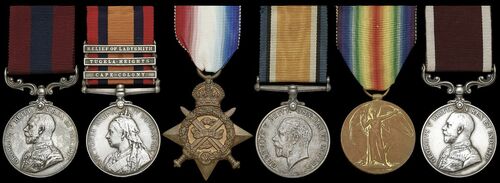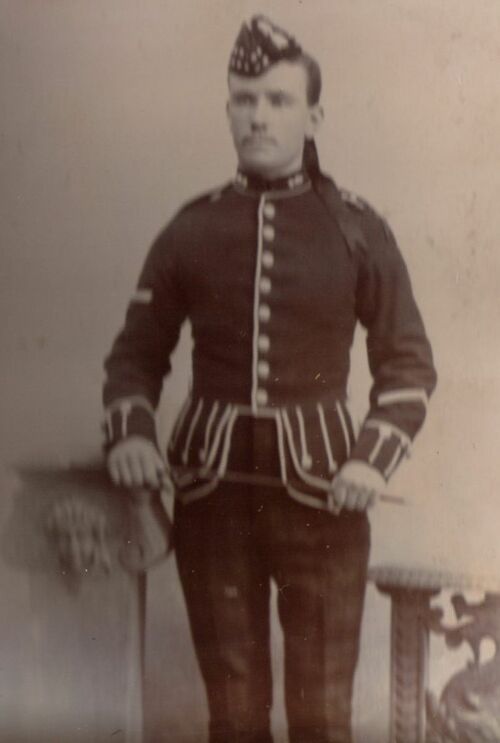Auction: 23003 - Orders, Decorations and Medals
Lot: 282
A 'Battle of the Aisne 1914' D.C.M. group of six awarded to Lance-Corporal G. A. Mack, 1st Battalion, Royal Scots Fusiliers, a veteran of the Battle of Spion Kop, for gallantry at Vailly on 14 September 1914, when he crossed 100 yards of open ground on three separate occasions to rescue wounded men who were lying in the open, the whole time being exposed to a heavy fire, also being 'mentioned'
Later transferred to the 2nd Battalion, he was killed in action on 23 April 1917 in the attack on the Village of Guémappe during the 'Second Battle of the Scarpe', an action which cost his Battalion 562 all ranks killed wounded and missing
Distinguished Conduct Medal G.V.R. (5523 L.Cpl G. A. Mack. 1/R. Sco: Fus.); Queen's South Africa 1899-1902, 3 clasps, Cape Colony, Tugela Heights, Relief of Ladysmith (5523 Corl G. A. Mack, 2: R. Scots Fus:); 1914 Star, Bar, an unnamed specimen; British War and Victory Medals, with M.I.D. oak leaves, (5523 W.O. CL. 2. G. A. Mack. R. S. Fus.); Army L.S. & G.C. Medal, G.V.R., 1st issue, (5523 Sjt: G. A. Mack. R. Sco: Fus:), good very fine (6)
D.C.M. London Gazette 1 April 1915:
'For conspicuous gallantry at Vailly, when he carried wounded men from the trenches into cover on three occasions, crossing a hundred yards of open ground under heavy fire.'
M.I.D. London Gazette 19 October 1914.
George Albert Mack was born in Islington, London, on 5 September 1880, the son of William and Sophia Mack. The family are recorded in both the 1881 and 1901 Census Returns residing in Islington and Bermondsey respectively, where his father's occupation is given as 'Blacksmith'.
Mack attested for service with the Royal Scots Fusiliers at London in 1898. Posted to the 2nd Battalion, he proceeded with them to South Africa and qualified for the Queen's South Africa Medal with clasps, 'Cape Colony', 'Tugela Heights', and 'Relief of Ladysmith'. He did not qualify for the King's South Africa Medal. The Queen's South Africa Medal Roll confirms that Mack transferred to the 1st Battalion whilst in South Africa, and he is recorded as such in the 1911 Census, aged 32 years, serving as a Private with the 1st Battalion which at the time was stationed at Robert's Heights, Pretoria, South Africa. During his pre-war service, Mack extended his army service to complete 12 years with the Colours, and subsequently re-engaged to complete 21 years colour service.
The 1st Battalion Royal Scots Fusiliers returned to the England on 30 July 1914, and on the outbreak of war was stationed at Gosport, Hampshire, having been assigned to the 9th Infantry Brigade, 3rd Division BEF. The Battalion entrained for Southampton on 13 August and embarked aboard the troopships 'S.S. Martaban' and 'S.S. Appam', landing at Le Havre the following day. Mack is confirmed as having entered the France and Flanders theatre of war with his unit on 14 August 1914.
He was awarded the Distinguished Conduct Medal for conspicuous gallantry on 14 September 1914 at Rouge Maison near Vailly-Sur-Aisne, when he crossed a 100 yards of open ground on three separate occasions whilst under a heavy fire to rescue wounded men who were lying in the open. During this action, the battalion lost 165 all ranks, killed, wounded and missing.
The Battalion War Diary entry for 14 September 1914 records the following:
'Ordered to march. A & D Coys ordered to support LINCOLNS at ORME. The advance was made over turnip fields and Coys were exposed to enfilade fire from Machine Guns. Capt BRIGGS ordered his Company to retire gradually and during the retirement he was killed. We had no support from Arty. During the retirement Capt MILLER was hit in the chest. 'B' and 'D' Coy under Major FORBES were ordered to support the 5th FUSRS on their right. 2nd Lt BETHELL was hit in the foot. Total casualties 8 killed, 67 wounded, 90 missing.'
In addition to the award of the DCM, Lance Corporal Mack's name was also brought to notice in Sir John French's Despatch dated 8 October 1914 for 'gallant and distinguished service in the Field'.
A staff officer, who visited this battalion after it had been in action for five weeks, noted:
'We came into the field occupied by the Royal Scots Fusiliers. Here they were drawn up, erect and grim as usual, but what a different regiment from the one which had swung out of Lyndhurst camp less than five weeks before! That magnificently smart regiment of once a thousand men was now reduced to about 70 men, with a junior subaltern in command. The men were mostly without caps, coats, or even putties, war-stained and ragged, but still full of British pluck and pride, with a "never say die" look upon their faces, which made the heart swell with pride at being connected with such splendid specimens of manhood.'
Mack returned to the England in 1915 and married Ada Francis Abraham at Portsmouth on 31 October 1915. At some point, he transferred back to the 2nd Battalion, Royal Scots Fusiliers which had been overwhelmed at Ypres on 31 October 1914 having to be re-constituted from drafts. The date of transfer is unknown. He was awarded the Long Service and Good Conduct Medal by authority of Army Order 121 of 1916, the date of recommendation being 1 January 1916.
The 2nd Battalion Royal Scots Fusiliers was re-assigned to 90th Brigade, 30th Division in December 1915. It launched an attack on the village of Guémappe, as part of 30th Division's advance east of Wancourt towards Vis-en-Artois on 23 April 1917, during the opening phase of the 'Second Battle of the Scarpe'. Although the battalion secured its objective, the attack had resulted in the loss of 562 all ranks, killed, wounded and missing, including Company Serjeant Major George Albert Mack who was listed as killed in action. He has no known grave, and his name is commemorated on the Arras Memorial, France. He was the husband of Ada Francis Mack (nee Abraham), of 6, Crown Street, Kingston, Portsmouth, and at the time of his death was 38 years of age.
For his services during the Great War, Mack was awarded the 1914 Star, British War and Victory Medals with MID Emblem. In accordance with Army Council policy, he was automatically granted the Clasp to the 1914 Star, as was all officers and men who would have qualified but as a result of being killed in action or died of wounds were no longer able to submit a claim; his entitlement being confirmed on the 1914 Star Roll.
Subject to 20% VAT on Buyer’s Premium. For more information please view Terms and Conditions for Buyers.
Sold for
£900
Starting price
£800







